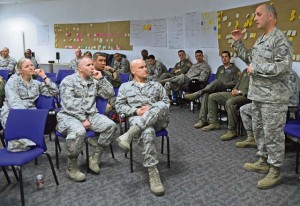
Airmen receive a briefing on Air Force Smart Operations for the 21st Century May 10 on Ramstein. AFSO21 focuses on improving mission capabilities to become more efficient across the Air Force.
Air Force Smart Operations for the 21st Century focuses on improving mission capabilities to become more efficient across the Air Force.
The program enables Airmen to change their day-to-day operations by playing beneficial roles in improving and maintaining the advantages and capabilities the Air Force provides for air, space and cyberspace.
“The most important aspect is increasing combat readiness,” said Randy Glick, 86th Airlift Wing AFSO21 facilitator.
“It’s about giving combatant commanders the resources they need to be effective on missions.”
AFSO21 is applicable across organizational and functional boundaries with the primary objective of improving combat capability.
It establishes a continuous process of development in an environment where Airmen are actively eliminating the waste of resources.
“It’s removing the diminishing resources and meeting mission requirements,” Glick said. “We need to get rid of non-value adding steps in the process of improvement.”
AFSO21 incorporates an eight-step improvement process that aligns with Air Force priorities by generating efficiencies and savings.
The first two steps fall under “observe”
Step one: Clarify and validate the problem.
Step two: Break down the problem and identify performance gaps.
The next two, “orient”
Step three: Target improvements.
Step four: Determine root causes as soon as possible.
Then, “decide”
Step five: Develop countermeasures to prevent making similar mistakes.
And, finally, “act”
Step six: See countermeasures through to completion.
Step seven: Confirm results and process.
Step eight: Standardize successful processes.
These steps can be applied to lean projects focused on immediate improvements as well as to larger business process re-engineering efforts that involve much more time and many more actions to implement and sustain improvements.
The Air Force must continue to use the right tools and techniques to improve upon mission capabilities across the Air Force.
“The program’s aim is simple: to support the wing’s strategic plan,” said Tara Mercado, 86th Force Support Squadron manpower and organization chief. “By eliminating non-value added activities in our major processes, we create a sustainable improvement culture in our Airmen.”







